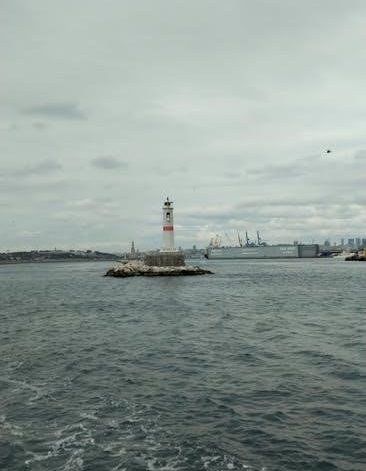St. John, the smallest U.S. Virgin Island, is a tropical paradise known for stunning beaches, lush national parks, and a relaxed island vibe. With over 60% of the island designated as protected land, it offers breathtaking natural beauty, vibrant coral reefs, and a rich cultural heritage. A perfect blend of tranquility and adventure, St. John attracts travelers seeking serene escapes, eco-tourism, and unforgettable Caribbean experiences.
Overview of St. John’s Location and Attractions
St. John, the smallest of the U.S. Virgin Islands, is located just four miles east of St. Thomas in the Caribbean Sea. Renowned for its pristine beaches, vibrant coral reefs, and lush landscapes, over 60% of the island is protected as a National Park. Attractions include iconic spots like Trunk Bay, Cinnamon Bay, and the Virgin Islands National Park, offering endless opportunities for snorkeling, hiking, and exploring. Its rich cultural heritage and stunning natural beauty make it a tropical gem.

Getting to St. John
St. John is accessible by ferry from St. Thomas, car ferries, or private charters. International arrivals must clear U.S. customs upon arrival.
Arriving by Ferry from St. Thomas
The most common route to St. John is via ferry from St. Thomas. Ferries depart from Red Hook or Charlotte Amalie, with Red Hook offering the most frequent service. The Red Hook to Cruz Bay ferry runs hourly, taking 15-20 minutes, while Charlotte Amalie ferries operate less frequently and take about 45 minutes. Tickets are affordable, with minimal baggage fees. Upon arrival in Cruz Bay, you’re steps away from the island’s heart. Porters are available to assist with luggage for a small tip.
Car Ferries and Private Boat Charters
Car ferries operate from Red Hook to Enighed Pond, south of Cruz Bay, allowing vehicles to reach St. John. Ferries run every 30 minutes during daylight, requiring early arrival due to limited space. Ensure your rental agreement permits ferry transport. For a personalized experience, private boat charters or water taxis offer direct transfers, ideal for late arrivals or luxury seekers. These options provide flexibility and convenience, though at a higher cost than public ferries.
U.S. Customs and Immigration Procedures
St. John’s U.S. Customs office is located in Cruz Bay at the Victor William Sewer Marine Facility. All international arrivals, such as those by private yacht from the BVI, must clear customs here. Passports and documentation are required, similar to airport procedures. The ROAM mobile app by CBP streamlines check-ins for pleasure boats. The office is open daily during business hours, and late arrivals must remain onboard until cleared. No customs are needed for ferry passengers from St. Thomas.

Getting Around St. John
St. John offers taxis, car rentals, and limited public transportation. Taxis are shared safari trucks, while renting a jeep is ideal for exploring the island’s hilly terrain.
Taxis and Safari Shuttles
Taxis and safari shuttles are the primary modes of transportation on St. John. These open-air vehicles, often modified pickup trucks with bench seating, operate on fixed, non-metered rates. Shared rides are common, making them a budget-friendly and social way to explore. Fares are determined by destination, with trips to beaches like Trunk Bay costing around $6-$10 per person. Confirm fares before departure, as costs can add up for groups. For remote areas, arrange private transfers or rentals in advance. Driving is on the left, so expect a unique experience!
Car Rentals and Driving Tips
Renting a Jeep or SUV is ideal for exploring St. John’s steep roads and scenic trails. Reserve in advance, especially during peak season, as options are limited. Drive on the left, following British-style rules, and navigate narrow, winding roads cautiously. Speed limits are low, and pull-offs help manage traffic. Consider 4WD for remote areas or villas with steep access. Parking in Cruz Bay is challenging, but many accommodations offer spots. Renting for specific days allows flexibility while exploring the island.
Public Transportation and Walking
St. John lacks an extensive public transportation network, but the VITRAN bus connects Cruz Bay to Coral Bay and the East End, mainly for locals. Its schedule is infrequent, making it unreliable for tourists. Hitchhiking is common for short trips but requires caution. Walking is ideal in Cruz Bay for exploring shops and restaurants, though sidewalks are scarce outside town. Hiking trails offer scenic alternatives, but long walks on hilly roads, especially at night, are not recommended due to safety concerns.
Accommodations on St. John
St. John offers diverse lodging options, from luxury resorts to cozy vacation rentals and eco-friendly stays, catering to all preferences and ensuring a memorable island experience.
Hotels and Resorts
St. John’s hotels and resorts offer a blend of luxury and charm, from the family-friendly Westin St. John Resort Villas to boutique hotels like Gallows Point Resort and Cruz Bay Boutique Hotel. Estate Lindholm provides a historic bed-and-breakfast experience, while Lovango Resort offers unique luxury accommodations. These options cater to diverse preferences, ensuring a comfortable and memorable stay on the island.
Vacation Rentals and Villas
St. John’s vacation rentals and villas provide intimate, magazine-worthy retreats with scenic views. From private villas perched on hills to beachfront properties, these accommodations offer a home-away-from-home experience. Many rentals feature modern amenities, pools, and outdoor spaces, perfect for families or romantic getaways. Villas often include personalized services, ensuring a luxurious and secluded stay amidst the island’s natural beauty.
Eco-Lodging and Camping
For nature enthusiasts, St. John offers eco-lodging and camping options that immerse guests in the island’s pristine environment. Eco-lodges provide sustainable, environmentally friendly accommodations, often with stunning views of the surrounding landscape. Camping is also available within the Virgin Islands National Park, allowing visitors to connect with nature. Permits are required for camping, and sites offer basic amenities for a rustic yet unforgettable experience amidst the island’s breathtaking natural beauty.
Dining on St. John
Indulge in St. John’s vibrant culinary scene, where fresh seafood, Caribbean flavors, and gourmet creations await. From beachside eateries to fine dining, every meal is a delight.
Top Restaurants and Dining Spots
St. John’s culinary scene is a fusion of Caribbean flavors and gourmet cuisine. The Fish Trap offers fresh seafood and waterfront views, while La Tapa serves innovative dishes with a tropical twist. ZoZo’s at the Sugar Mill combines Italian and Caribbean flavors in a historic setting. For a casual vibe, The Beach Bar in Cruz Bay is perfect for burgers and cocktails. These spots cater to diverse tastes, ensuring memorable dining experiences.
Local Cuisine and Food Culture
St. John’s cuisine is a vibrant blend of Caribbean, seafood, and American flavors. Fresh catches like mahi-mahi and lobster are staples, while conch fritters and fish tacos are local favorites. Traditional dishes like jerk chicken and callaloo reflect the island’s cultural heritage. Local ingredients such as mangoes, coconuts, and fresh herbs are often featured. The island’s food trucks and beachside eateries offer authentic, laid-back dining experiences, while rum-based cocktails like the Painkiller add a tropical touch to every meal.
Beaches and Activities
St. John boasts stunning beaches like Trunk Bay and Caneel Bay, offering crystal-clear waters for swimming and snorkeling. Hiking trails in the national park provide scenic adventures.
Popular Beaches and Snorkeling Spots
St. John is renowned for its pristine beaches and vibrant snorkeling spots; Trunk Bay, with its calm waters, is a favorite for swimmers and snorkelers. Caneel Bay offers secluded white sands, while Maho Bay is perfect for spotting sea turtles. Cinnamon Bay provides ample opportunities for kayaking and paddleboarding. These beaches, surrounded by lush greenery, create a tropical paradise for visitors seeking relaxation and underwater exploration.
Water Sports and Outdoor Adventures
St. John offers a variety of water sports and outdoor adventures. Kayaking, paddleboarding, and snorkeling are popular, with vibrant coral reefs to explore. Hiking through the Virgin Islands National Park provides breathtaking views, while boat charters and sailing excursions reveal hidden coves. Zip-lining and eco-tourism activities allow visitors to immerse themselves in nature. These experiences make St. John a paradise for those seeking adventure and connection with the island’s pristine environment.
Cultural and Historical Sites
St. John’s rich history is preserved in its museums, historical landmarks, and ancient petroglyphs. Explore Annaberg Plantation, Reef Bay’s pre-Columbian carvings, and Cruz Bay’s vibrant cultural heritage.
Museums and Historical Landmarks
St. John is home to a variety of museums and historical landmarks that showcase its rich cultural and colonial past. Visit the Annaberg Plantation, a restored 18th-century sugar plantation, to explore its historical ruins and learn about the island’s sugar production history. The Reef Bay Sugar Mill, another notable site, features ancient petroglyphs carved by Taino Indians. These landmarks offer a glimpse into St. John’s diverse heritage, blending colonial history with indigenous influences.
National Park and Eco-Tourism
Over 60% of St. John is protected as Virgin Islands National Park, offering vast opportunities for eco-tourism. Hike the Reef Bay Trail, explore ancient petroglyphs, or snorkel in crystal-clear waters teeming with marine life. The park’s lush landscapes, scenic beaches, and diverse wildlife create a paradise for nature enthusiasts. Eco-friendly accommodations and sustainable tourism practices ensure the island’s natural beauty is preserved for future generations to enjoy.

Day Trips and Excursions
Explore nearby islands, hidden beaches, and vibrant coral reefs through boat charters or guided tours. Discover the British Virgin Islands or experience thrilling water sports and snorkeling adventures.
Boat Charters and Nearby Islands
Experience the Caribbean’s beauty with boat charters to nearby islands like the British Virgin Islands. Visit Jost Van Dyke for idyllic beaches or Norman Island for snorkeling. Private charters offer flexibility, while group tours provide social experiences. Explore hidden coves, vibrant reefs, and secluded beaches. Book in advance, especially during peak season, and pack essentials like snorkeling gear and sunscreen for an unforgettable day trip.
Guided Tours and Activities
St. John offers a variety of guided tours, from snorkeling trips to cultural explorations. Explore the Virgin Islands National Park with expert guides, discovering hidden trails and historical sites. Snorkeling tours reveal vibrant coral reefs, while boat excursions visit secluded beaches. Eco-tours focus on wildlife and conservation, offering unique insights into the island’s natural beauty. Whether you’re interested in adventure or history, guided tours provide unforgettable experiences tailored to your interests.

Shopping on St. John
St. John offers a unique shopping experience with local boutiques, artisan markets, and galleries. Discover handmade jewelry, island crafts, and tropical-inspired souvenirs, perfect for memorable keepsakes.
Local Shops and Markets
St. John’s charming local shops and markets offer a variety of unique treasures. From handmade jewelry and island crafts to tropical-inspired apparel, these boutiques showcase the island’s culture. Mongoose Junction and Wharfside Village are popular spots for shopping, with many stores featuring work by local artisans. Markets often include fresh produce, spices, and handmade goods, providing a taste of the island’s authentic charm and creativity.
Unique Souvenirs and Island Products
St. John offers a variety of unique souvenirs and island products perfect for memorable keepsakes. Local artisans craft handmade jewelry, pottery, and textiles inspired by the island’s tropical beauty. Coconut-based products, rum-infused treats, and Virgin Islands-made spices are popular choices. Many shops in Cruz Bay and Coral Bay feature these items, allowing visitors to take a piece of the island’s culture home. Supporting local vendors helps sustain the community’s vibrant craftsmanship.
Essential Planning Tips
Plan ahead for St. John: best weather from December to April, pack reef-safe sunscreen, and respect local customs. Stay informed on travel requirements and island etiquette.
Best Time to Visit and Weather
The best time to visit St. John is from December to April, offering dry, cooler weather ideal for outdoor activities. Daytime temperatures range from the mid-80s°F, while evenings are pleasant in the 70s°F. This period is peak tourist season, with higher prices and larger crowds. The wet season, from May to November, brings occasional rain and humidity, with hurricane season posing risks. Plan accordingly for a memorable Caribbean getaway.
Health, Safety, and Travel Tips
Ensure health and safety by staying hydrated, using reef-safe sunscreen, and respecting marine life. Be cautious of strong currents at beaches and secure valuables in public areas. Avoid walking alone at night in isolated spots. Rent a reliable 4WD vehicle for steep roads and bring insect repellent. Check the latest COVID-19 guidelines before traveling. Plan ahead, stay informed, and enjoy St. John’s serene beauty responsibly.




